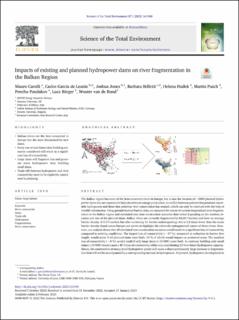| dc.contributor.author | Carolli, Mauro | |
| dc.contributor.author | de Leániz, Carlos García | |
| dc.contributor.author | Jones, Joshua | |
| dc.contributor.author | Belletti, Barbara | |
| dc.contributor.author | Hudek, Helena | |
| dc.contributor.author | Pusch, Martin T. | |
| dc.contributor.author | Pandakov, Pencho | |
| dc.contributor.author | Börger, Luca | |
| dc.contributor.author | van de Bund, Wouter | |
| dc.date.accessioned | 2023-02-22T12:21:15Z | |
| dc.date.available | 2023-02-22T12:21:15Z | |
| dc.date.created | 2023-02-07T15:31:41Z | |
| dc.date.issued | 2023 | |
| dc.identifier.issn | 0048-9697 | |
| dc.identifier.uri | https://hdl.handle.net/11250/3053267 | |
| dc.description.abstract | The Balkan region has some of the best conserved rivers in Europe, but is also the location of ~3000 planned hydropower dams that are expected to help decarbonise energy production. A conflict between policies that promote renewable hydropower and those that prioritise river conservation has ensued, which can only be resolved with the help of reliable information. Using ground-truthed barrier data, we analysed the extent of current longitudinal river fragmentation in the Balkan region and simulated nine dam construction scenarios that varied depending on the number, location and size of the planned dams. Balkan rivers are currently fragmented by 83,017 barriers and have an average barrier density of 0.33 barriers/km after correcting for barrier underreporting; this is 2.2 times lower than the mean barrier density found across Europe and serves to highlight the relatively unfragmented nature of these rivers. However, our analysis shows that all simulated dam construction scenarios would result in a significant loss of connectivity compared to existing conditions. The largest loss of connectivity (−47 %), measured as reduction in barrier-free length, would occur if all planned dams were built, 20 % of which would impact on protected areas. The smallest loss of connectivity (−8 %) would result if only large dams (>10 MW) were built. In contrast, building only small dams (<10 MW) would cause a 45 % loss of connectivity while only contributing 32 % to future hydropower capacity. Hence, the construction of many small hydropower plants will cause a disproportionately large increase in fragmentation that will not be accompanied by a corresponding increase in hydropower. At present, hydropower development in the Balkan rivers does not require Strategic Environmental Assessment, and does not consider cumulative impacts. We encourage planners and policy makers to explicitly consider trade-offs between gains in hydropower and losses in river connectivity at the river basin scale. | en_US |
| dc.description.abstract | Impacts of existing and planned hydropower dams on river fragmentation in the Balkan Region | en_US |
| dc.language.iso | eng | en_US |
| dc.publisher | Elsevier | en_US |
| dc.rights | Navngivelse 4.0 Internasjonal | * |
| dc.rights.uri | http://creativecommons.org/licenses/by/4.0/deed.no | * |
| dc.title | Impacts of existing and planned hydropower dams on river fragmentation in the Balkan Region | en_US |
| dc.title.alternative | Impacts of existing and planned hydropower dams on river fragmentation in the Balkan Region | en_US |
| dc.type | Peer reviewed | en_US |
| dc.type | Journal article | en_US |
| dc.description.version | publishedVersion | en_US |
| dc.rights.holder | The Authors | en_US |
| dc.source.volume | 871 | en_US |
| dc.source.journal | Science of the Total Environment | en_US |
| dc.identifier.doi | 10.1016/j.scitotenv.2023.161940 | |
| dc.identifier.cristin | 2123833 | |
| dc.relation.project | EC/H2020/689682 | en_US |
| dc.relation.project | Norges forskningsråd: 257588 | en_US |
| dc.source.articlenumber | 161940 | en_US |
| cristin.ispublished | true | |
| cristin.fulltext | original | |
| cristin.qualitycode | 2 | |

